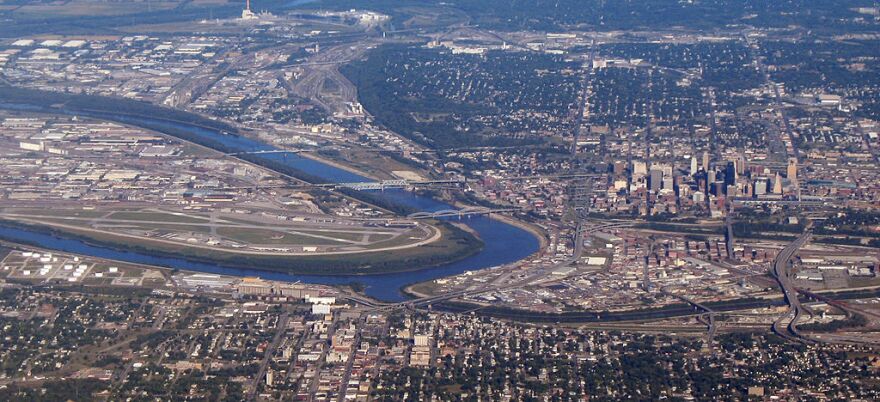It's common knowledge among Kansas Citians that much of Johnson County, Kan., is suburban, while Kansas City, Kan., proper is an urban core.
What might not be common knowledge is that Overland Park, Kan., has a larger total population count and higher employment density than KCK. So is it still a suburb?
As we turn to the Wyandotte/Johnson County line as part of our Beyond Our Borders project, we're taking a look at what distinguishes an urban core from a suburb, and how that could be changing.
Urban, suburban and rural
If you go by the U.S. Census Bureau's definition, any city that has more than 2,500 inhabitants is an "urban cluster." Any city with more than 50,000 people is considered an "urbanized area."
Any area that doesn't meet the cluster threshold is considered rural. By those definitions, most cities in Wyandotte and Johnson counties are urban. In fact, the Census doesn't even differentiate suburbs from rural or urban areas, despite the fact that they've been an important part of America's development as a country.
Historical considerations
The Mid-America Regional Council considers the Kansas City metro to have urban, rural and suburban areas, though there isn't a clear cut definition of what exactly a suburb is. Andrea Repinksy of MARC says what constitutes as "suburban" is constantly changing as our area grows and develops.
"Many originally suburban areas, like the Country Club Plaza, are now considered by most to be urban," Repinsky says. "Conversely, new suburban developments like Park Place in Leawood, Kan., have densities and are designed to approximate the look and feel of many areas considered urban."
MARC Director of Research Services Frank Lenk agrees with Repinsky that history plays a big part in determining what a suburb is in an increasingly urban world.
"Originally [in the 1950s], all the jobs except retail were in the urban area while suburban areas were simply bedroom communities where the workers lived," Lenk says. "Now, that is no longer the case with suburban areas taking on some urban characteristics."
City planning is also a big factor in determining how a city will grow over the years. Kansas City, Kan., may have fewer people living within its borders than Overland Park, but, according to Lenk, the density of businesses and streets are what make it distinctly urban.
"The small size and high density of the parcels, denser street networks that make walking to many destinations a real possibility, the capacity to support much larger populations because very high densities are allowed and encouraged – these are the hallmarks of urban areas," Lenk says. "A single simple metric like population density today simply doesn’t capture all that we mean by the terms 'urban' and 'suburban.'"
The culture of the suburb
The University of Missouri-Kansas City's Urban Planning Program Director Michael Frisch believes that defining a city as "suburban" is largely a cultural distinction.
"There's still some meaning to the word 'suburban,' and it's connected to a specific lifestyle," Frisch said. "That lifestyle, generally, is car related, [and] it brings some connotations of family structure."
Frisch also said that the larger suburbs of Kansas City have been developing in a way that makes them urban-suburban hybrids rather than strictly one or the other. As an example, Frisch says Overland Park is a suburb historically, but more people come into the city than go out to work, which is typically a feature of an urban city.
When asked whether Johnson County's suburbs can ever truly be considered urban centers, Frisch was undecided.
"No matter how big Overland Park gets, Kansas City will be the primary city," Frisch said. "[Overland Park] probably can't ever get to that same point, but who knows?"
University of Kansas Urban Planning professor Kirk McClure says that he considers all of the Kansas City metro cities outside of Kansas City, Mo., to be suburban. But that doesn't mean they're strictly bedroom communities centered around residential life.
"A suburb is anything that isn't a central city," McClure said. "The distinction between central cities, like Kansas City, Mo., and suburban cities is fading, and has been for a long time."
By McClure's definition, even KCK would be a suburban city by the very fact that it isn't the central city in the metro area. So by his definition Johnson County and Wyandotte County are very much alike — they're the Kansas City suburbs.
This look at the two sides of the Wyandotte County/Johnson County line is part of KCUR's months-long examination of how geographic borders affect our daily lives in Kansas City. KCUR will go Beyond Our Borders and spark a community conversation through social outreach and innovative journalism.
We will share the history of these lines, how the borders affect the current Kansas City experience and what’s being done to bridge or dissolve them. Become a source for KCUR as we investigate Johnson and Wyandotte Counties.




